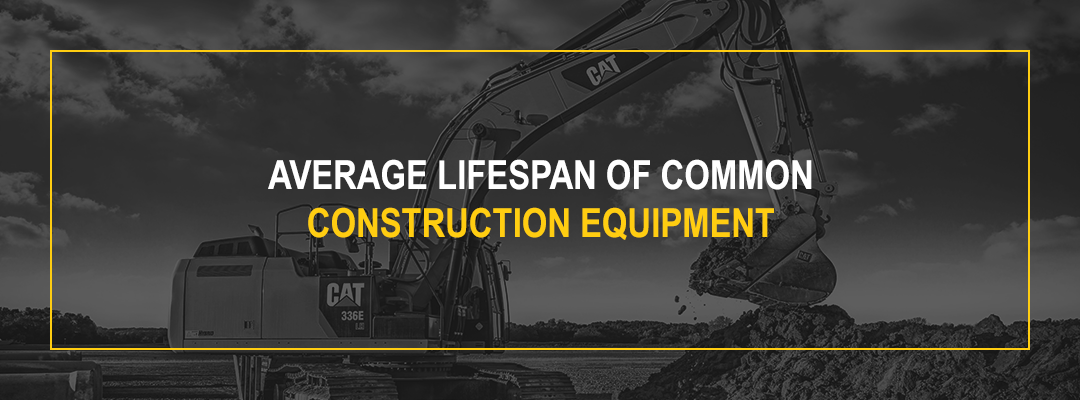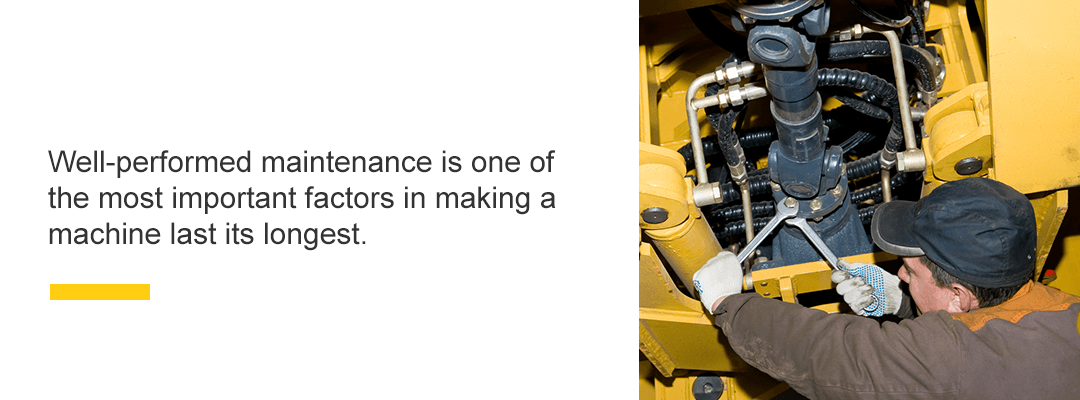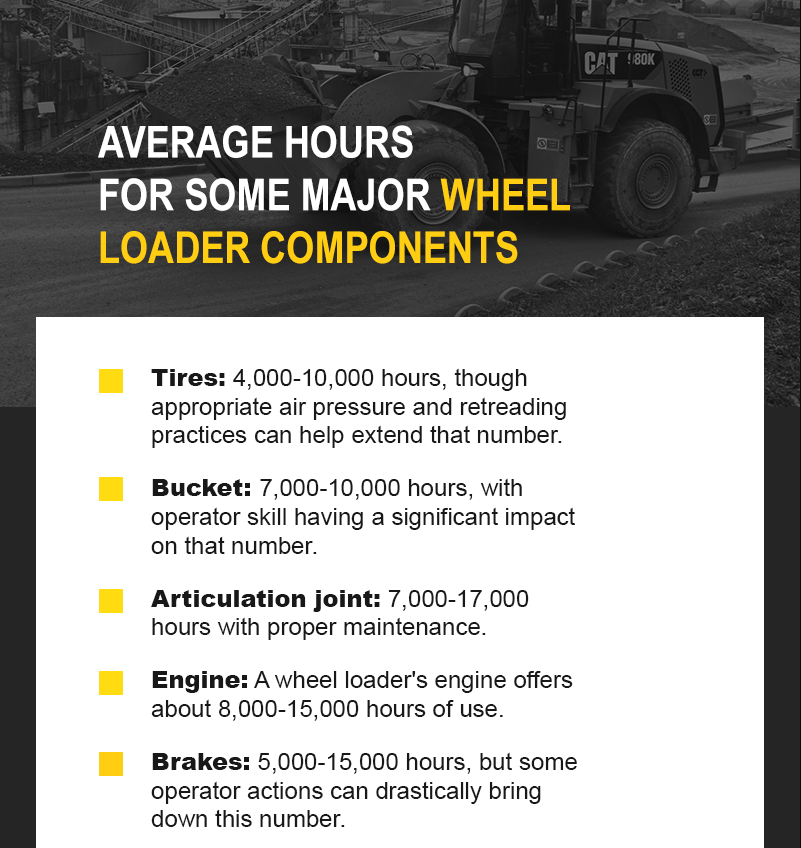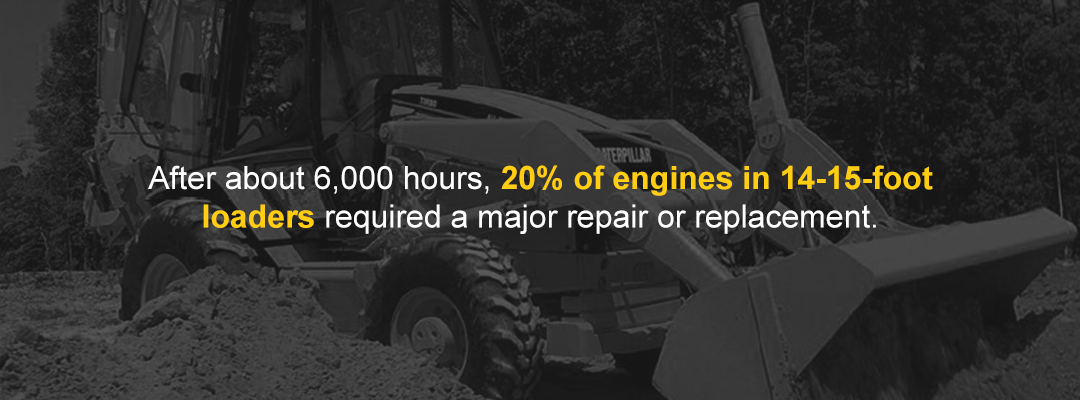
When you purchase equipment, you want to know how long you can expect it to last. The average lifespan of construction equipment varies from machine to machine, and many factors will influence how long its components continue to work.
Your heavy equipment’s lifespan is an essential aspect of getting the most value and profitability from it. It influences your owning and operating costs (O&O) and determines how long you can go before purchasing a new one. To help you better understand typical equipment lifetime, we’ll be going over some of the most common pieces of equipment, their average lifetimes and factors that influence them. We’ll also go over a few tips for increasing the longevity of your machinery.
How Long Will My Equipment Last?
While there are general expectations for each type of equipment, (see below) the useful life of your equipment relies on a lot of different factors and varies according to what you value most in your equipment. Each business will have a different decision point where they view their equipment as being too costly to continue to use. Various pieces of equipment may be more tolerant of being pushed past their expected lifetimes. As components break down, you’ll have to weigh the benefits of repair and replacements against the value of retiring it and selling the equipment. Many businesses choose to replace a piece of equipment when the cost to repair it exceeds the value of the piece of equipment, were it to sell today.
Most heavy machinery experiences a “sweet spot” of ownership, where the O&O cost of the equipment levels out to its lowest point. Before that sweet spot, you’re often looking at a high rate of depreciation for new equipment during the first years of owning it. This rate can lower the machine’s resale value and brings up your O&O costs. At a certain point, though, this rate levels out, while your machinery continues to offer value and performance. As your equipment continues to age, maintenance and repair costs start to rise, bringing up the O&O costs. Around this stage is when most owners find that the cost outweighs the value of the equipment, and it is time to look at refurbishing or purchasing a new machine.
Some of the factors that will influence the construction equipment lifecycle include the following:
- Environment: Exposing a piece of machinery to extreme heat or cold, abrasive materials, irregular surfaces and other environmental difficulties will take its toll on the equipment. You can help minimize these effects with specific preventative actions, like winterizing, using appropriate tires and pressure and storing a machine indoors during periods of prolonged disuse. Still, a harsh environment can significantly diminish a piece of equipment’s expected lifespan. Tools used indoors, like electric forklifts, are likely to have a longer lifespan than its outdoor equivalent.
- Maintenance: Appropriate maintenance will do wonders for the life of a piece of equipment. Keeping up-to-date with necessary tasks like filter and fluid changes, greasing parts and performing regular inspections and repairs can keep equipment working at its most efficient and alert you to any problems before they necessitate major work or expenses. Ensuring your operators are well-trained on daily and weekly maintenance tasks can help them keep a close eye on it. Well-performed maintenance is one of the most important factors in making a machine last its longest. Working with Cat® dealers can offer you access to comprehensive maintenance solutions.
- Operator error: One significant reason for shorter equipment lifetimes is simple operator error. Just like you can drive a car in ways that aren’t healthy for it, operators can run heavy machinery in ways that damage it or put extra wear on components. They may move it in ways that put extra strain on the motor or brakes or consume more fuel than necessary. Provide training to help operators balance power and efficiency to extend the life of your equipment. Some machinery also has technology designed to give you reports on usage and how exactly it is being operated. These reports can help you address issues in operation and keep things running smoothly.
With many of the all-encompassing factors out of the way, let’s take a look at some individual pieces of machinery and what their expected equipment lifetimes look like.
1. Wheel Loader
Most general contractors put about 1,200-1,500 hours on their wheel loaders each year. A wheel loader’s average lifespan is about 10 years, or 7,000-12,000 hours.
If you’re wondering how long your wheel loader will last, take a close look at your operators. Making a wheel loader last is all about minimizing the effects of human error. These machines are susceptible to the damage that operators can cause through everyday use, such as excessive use of the brakes or shock loading the drive train. Thankfully, newer machines can have technology that helps adjust for these errors. Looking for these tools, such as acceleration control and clutch modulation, can help you get more from your wheel loader, even with operator error in place.
Another significant effect on wheel loaders is the layout of the job site. Steep slopes, for instance, can negatively influence the component lifecycle. Try to optimize the job site for your equipment.
Additionally, the many different components of a wheel loader have their typical lifespans as well. Here are the expected average hours for some major wheel loader components:
- Tires: Tires typically last 4,000-10,000 hours, though appropriate air pressure and retreading practices can help extend that number. Using tires on harsh surfaces or with inappropriate pressure or ballast is a surefire way to shorten their usable life. Be sure you’re using the correct tires for the terrain to keep them moving.
- Bucket: The bucket of a wheel loader can usually last 7,000-10,000 hours, with operator skill having a significant impact on that number. Maintenance is another crucial factor in keeping a bucket in good condition. Regularly inspect buckets for wear and scalloping.
- Articulation joint: The articulation joint typically lasts for 7,000-17,000 hours with proper maintenance. Abrasive materials can quickly shorten that number for the pins and bushings, no matter how well-maintained the joint is. You’ll also want to make sure you properly adjust the joint as needed.
- Engine: A wheel loader’s engine offers about 8,000-15,000 hours of use. Partial or in-frame rebuilds can provide more life for an engine without the full cost of a replacement.
- Brakes: Brakes usually last for about 5,000-15,000 hours, but some operator actions can drastically bring down this number. If they ride the breaks, take ramps or run on short duty cycles, they can diminish the lifespan of brakes. Inboard wet disk breaks offer much longer usage.
Wheel loaders can last a long time, but individual components may necessitate repairs or replacements throughout ownership.
2. Forklift
The typical lifespan of a forklift tends to be around 10,000 working hours, but there are several factors that affect how long a forklift will last, such as:
- Typical operating environment — for example, whether the forklift is operated regularly in challenging or uneven terrain
- Maintenance frequency
- Type of forklift and model year
- Number of running hours
- The forklift’s exposure to excessively cold or warm temperatures
- How often the forklift is used to carry very heavy loads
Forklifts are one of those tools that has electric variants. If used in a clean, indoor environment, these electric forklifts are likely to last longer, but keep in mind that their batteries will only last a certain number of charges before they need replacement. They also can see more wear if you use them outdoors. Rough outdoor climates and poor maintenance can shorten the usable hours of a forklift.
Regular maintenance can extend the life of a forklift. Keeping components greased and watching for hydraulic issues can prevent problems with the forklift down the road.
3. Excavator
Many contractors end up taking hydraulic excavators out of primary production at about 9,800 hours of use. By the time an excavator reaches that number, most components, aside from the engine, have seen some sort of major repair or replacement. Mini-excavators typically offer a similar average lifespan of around 10,000 hours.
For both excavators and mini-excavators, you’ll want to pay special attention to the undercarriage wear and the condition of the tracks. Both of these areas can show signs of wear and mechanical issues that can interrupt normal functioning.
4. Dozer
Bulldozers, like excavators, need special attention to their undercarriage, which supports a powerful machine and is subject to its operating conditions. Make sure that the dozer has an undercarriage specified for the correct type of work you’re using it in. For instance, hauling soil across flat ground isn’t going to put near as much stress on the undercarriage as heavy or abrasive materials handling in a landfill, crawling over miscellaneous items and tough terrain. The differentiation between standard and heavy-duty undercarriages exists for a reason. Following proper handling and best practices for operation, such as limiting reversing, can also help minimize damage to the undercarriage.
The average bulldozer lifespan is about seven to 10 years for most contractors.
5. Backhoe Loader
Backhoe loaders don’t tend to last as long as some of the other pieces of machinery we’ve mentioned. After about 6,000 hours, 20% of engines in 14-15-foot loaders required a major repair or replacement. Typically, by 8,500 hours, 50% of the components in a backhoe loader have reached their end and fail within 3,500 hours.
There isn’t a huge difference between the type of work the backhoe loader is doing either. General use and heavy-duty machines see similar engine and transmission life, but axle life can take a big hit of about 19% in heavy-duty work.
Paying attention to component lifecycles is useful for backhoe loaders, but oil-analysis histories can give a more accurate reflection of your machine’s remaining life.
6. Scraper
Scrapers are one of the longer-lasting pieces of heavy machinery, and contractors don’t usually have much trouble pushing them past their prime. When talking about how long components will last, you’ll often see the numbers like B20, B50 and B80, which refer to different points in the component lifecycle. The B50 life of a machine is the point at which half of its components have failed, and this typically marks the farthest edge of use for most equipment. Usually, manufacturers suggest retiring equipment at that point, as components typically begin to fail at a swift rate after reaching this threshold.
Motor scrapers — along with the next few machines on our list — last quite a bit longer than most, mainly because there is less risk in pushing them past that B50 life. About 20% of motor scrapers are still in use at 25,000 hours. Half of them stay in primary production roles at 13,000 hours. Investing in quality maintenance can often extend the life of these machines.
7. Motor Grader
The motor grader is similar to scrapers in that there is little risk to push it past its anticipated B50 component life, which is about 12,000 hours. At 20,000 hours, 20% of motor graders still stand in primary production.
Of course, regular maintenance is still one of the best ways to lengthen the life of this machine, especially if operating it under challenging conditions, like on rocky ground or in dusty environments. Certain operating practices, such as changing the blade to the back position to sharpen it or switching to the left lead during grading along curbs, can help increase its lifespan as well. Overall, motor graders aren’t too difficult to keep in good shape, with easy maintenance and access to parts. Regular inspections are also key to keeping blades in top condition.
8. Crawler Loader
Crawler loaders also offer an extensive lifespan. They usually reach their B80 component life, or the point where 80% of components have failed, at 18,000 hours. It’s not uncommon for contractors to get 20,000+ hours out of one. O&O doesn’t tend to climb until about year 14. Since these machines are so versatile and last a long time, they can be an efficient tool at your disposal.
Again, the undercarriage is a significant consideration when looking at wear and tear. Operating conditions will determine how long a crawler loader will last, but general contractors are often looking at about 6,000-7,000 hours for the average track loader lifespan before requiring a rebuild. Rebuilds for the engine and hydraulic system might be necessary at about 10,000-12,000 hours.
Get More Life From Your Equipment With Thompson Tractor
The lifespan of machinery can fluctuate wildly with influences ranging from the type of equipment it is to the habits of the operator and the quality of maintenance it receives. All of these aspects can help or hurt the life of heavy machinery. If you’re looking to buy used equipment, which offers plenty of contractors a way to save money without sacrificing quality, you need to know the history of your machinery.
Working with Thompson Tractor offers detailed histories, testing, and Cat Certified Used products you can trust to maintain the performance of a new machine. Plus, when you buy Cat machines from Thompson Tractor, you are buying a machine backed by the Caterpillar brand. That means long-lasting quality and exceptional resale value.
Visit one of our Thompson Tractor locations to explore equipment and discuss your needs with our experts.
Cat Certified Used Machines
Check out our selection of used CAT heavy equipment and see how they can get to work for your business. Certified quality & reliability.




